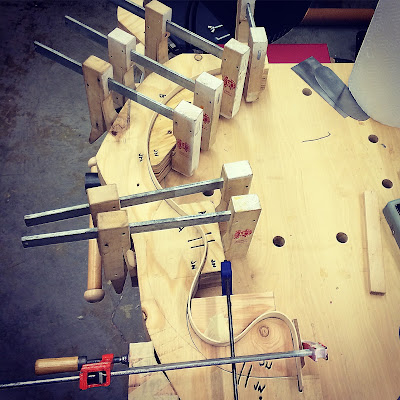For this guitar, I based the bracing pattern off a 1931 Martin 00-40H. I used Adirondack Spruce for the x-brace, lower transverse, and finger braces. The upper transverse brace is a 3-ply laminate of Adirondack and Rosewood, the upper graft and sound hole braces are made of Sitka Spruce, and the bridge plate is Maple. I chose to approach the shaping of the braces in a traditional Martin style, bringing the profile to a triangular shape and scalloping the lower transverse and x-braces. This process was done entirely by hand using chisels and finger planes to carve the braces, flexing and checking the tops stiffness often. Once I started to reached my desired rigidity, I tested the tap tone by holding the top lightly while taping in various locations. I listened closely to the tone and sustain of the material while making small changes to the bracing until I was happy with the voice of this instrument, a process that I thoroughly enjoy.






Next, I prepared the rib structure for glueing the top. I started by installing spruce side braces and sanded the kerfing and neck block flat in the upper bout. I sanded to a 50' radius in the lower bout matching the radius of the constructed top. I notched for the upper transverse and x-braces by tracing the outline of the braces to the kerfing and cut the material away with a chisel until the brace ends fit snugly in place. I applied glue and laced a bungee over the top for clamping pressure. Once dry, I flush trimmed the excess top wood using a router.




I started work on the Rosewood back while waiting for the glue to dry. I used Sitka spruce for a center strip, and sanded a radius into it once it was dry to give it a clean appearance. I used Adirondack spruce for the back braces, and glued them in place using the go bar deck in a 25' radius dish.


- Justin Ness
















































